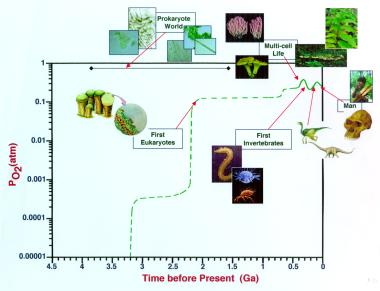Evidence for Earliest Earth LifeMost of the evidence of the earliest life on Earth is in the form of
chemical tracers: there are few truly ancient fossils.
Figure 2. Evolution of life on Earth as related to the appearance of oxygen in the atmosphere. The plot of oxygen versus time is modeled after the data of Rye and Holland (1999), who have proposed this pattern as the most likely based on studies of ancient soils (paleosols). The pictures of organisms are meant to emphasize that the early Earth was colonized by simple organisms, probably prokaryotic in nature, and that complex organisms (multicellular large creatures) did not appear until the oxygen levels were near to what they are now, approximately 500 million years ago. However, even before the rise of oxygen, Earth was teeming with microbial life -- this is the perspective that must be kept in mind when searching for life on other planets of unknown evolutionary age. Indeed, other planets could be in any of these stages, and the search for life can not simply assume that a given stage of life or planetary evolution will have been reached. One should also keep in mind that the evolution of Earth has been drastically impacted by life. The oxygen we breathe is a product of the early evolution of photosynthesis, which supplies it. Without this innovation, the planet might well be alive, but its life would look much different from what we see today.
Contributed by: Dr. Kenneth Nealson |






